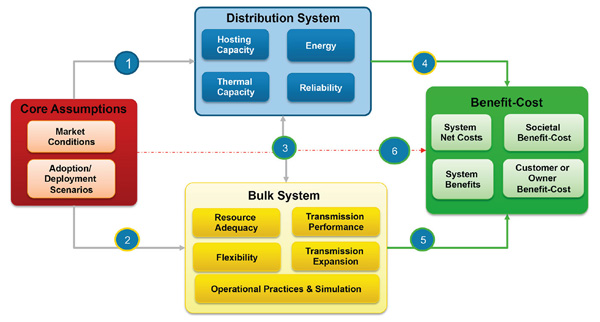An innovative research and education initiative could help bridge the gap between distributed resources and the bulk power system, encouraging the use of smart technology to deliver benefits and opportunities that would not have been possible without the new integrated approaches. Titled “The Integrated Grid,” the wide-ranging project is intended to drive toward optimal integration of distributed and centralized energy resources. The instigator is EPRI, the Electric Power Research Institute, a long established technical agency working for the benefit of electric power system users.
Featuring 21 pilot projects, a host of research initiatives, an online community and more, one of the key features of the Integrated Grid is its effort to develop and refine a comprehensive Benefit-Cost Framework for grid development initiatives.
 Establishing significant power system transformation as part of its premise, the project’s statement of purpose notes that “Through a combination of technological improvements, policy incentives, and consumer choices in technology and service, the framework of the industry is changing.” A central goal is “to realize the full value of a transformed power system – its diverse inputs, efficiencies and innovation.” Project literature notes that “Benefits and costs must be characterized at the local level and the aggregated level of the overall power grid ... this requires adopting planning protocols and operating procedures that see interconnected assets from end to end, and that operate the system in an integrated manner.”
Establishing significant power system transformation as part of its premise, the project’s statement of purpose notes that “Through a combination of technological improvements, policy incentives, and consumer choices in technology and service, the framework of the industry is changing.” A central goal is “to realize the full value of a transformed power system – its diverse inputs, efficiencies and innovation.” Project literature notes that “Benefits and costs must be characterized at the local level and the aggregated level of the overall power grid ... this requires adopting planning protocols and operating procedures that see interconnected assets from end to end, and that operate the system in an integrated manner.”
In its Executive Summary of the project, EPRI explains that its benefit-cost methodology is intended to define the tools, protocols, and methods necessary to conduct consistent, repeatable, and transparent studies to anticipate and accommodate distributed energy resources (DER). “Coordinated efforts employing a common evaluation framework accelerate the pace of understanding of the net benefits of DER and how to maximize them.”
The study methodology stresses systematic collection of data on costs and avoided costs: “These are aggregated categorically, making a distinction between benefits and costs. Other impacts define changes in the system that are tangible and should be identified and quantified but that are not readily monetized because they are not transacted in the electricity (or any) market. Emissions associated with electricity generation, changes in delivery reliability, and changes in the economy (such as employments and wages) are examples of externalities for which there are no market transactions to definitively set a value for their level. From a societal perspective, as many benefits and costs as possible should be monetized so that the net benefits derived are all-inclusive to reflect the utility’s and its customers’ interests as well as those of all economic sectors and all citizens. Alternatives for doing so are proposed in the framework.”
It is a sizable undertaking but one that is best approached in a comprehensive cross-jurisdictional fashion. EPRI explains: “The temporal nature and nuances of the bulk power system require dynamic load modeling and forecasting capabilities along with probabilistic capacity adequacy analyses to account for the inherently intermittent nature of supply of some DER. The same holds for assessing impacts on the transmission system. Distribution planning models need to be integrated with those of the bulk power system for planning to be truly integrated.”
Despite having a well-developed framework, the tools are not final, and should be understood as a work in progress. EPRI notes that it “seeks and welcomes ongoing collaboration with industry stakeholders to improve on the Integrated Grid framework to ensure that it develops intelligently and purposefully and is accessible to and used by the industry at large as well as by those who study the operation and performance of the electric system.”
Pilot projects have been developed to assist with the testing of the methodology. “The technologies developed and operating procedures formulated must be subjected to rigorous, in situ field testing to ensure that they perform as intended.” The projects include:
• Utility-scale photovoltaic (PV), with and without storage
• Distributed storage
• Microgrids
• Electric Vehicle charging infrastructure, and
• Customer-side technologies and devices used by customers to control when and how much electricity they use.
For many market participants concerned with DER, the EPRI initiative may be a significant step forward in broadening understanding of the field and developing widely shared forms of analysis. The Executive Summary concludes by saying, “The transition to the Integrated Grid is beyond the scope of any one organization. It requires careful collaboration among multiple parties sharing a mutual interest in DER integration. EPRI intends to promote and support ongoing technology assessments and performance documentation efforts in conjunction with other stakeholders. It plans to work with utilities in the United States and around the globe to coordinate system pilots, deployments, and modeling efforts that contribute to the improved understanding of how to accommodate DER.”
For more information on the Integrated Grid Initiative, readers may visit
